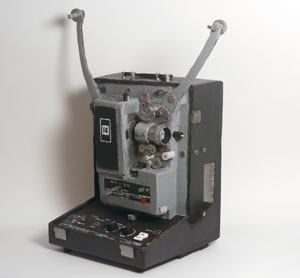Start at the beginning. Joel Schlemowitz does, but not for a fresh start. He loves new beginnings and happy endings, the old-fashioned way, on celluloid. Forget streaming. He is going back to the movies, only that, too, comes with a twist. This is art—where, as ever, things are not always what they seem, at Microscope through December 2. Old media get a new look.
Movies have their stereotypical beginnings and endings, but also real ones that theater-goers may never see. No, not chance meetings, cute fighting, and big kisses but the big count. It comes still earlier and later, and it may not make it onto the screen, but you know it well—that strip of 16 mm film with the count-down to one and whatever else the producer and projectionist require, such as the state seals of New York and California. For Schlemowitz, the industry is still bicoastal or even global. His scraps of film have become paintings, and the cameras that produced them have become sculpture. An expert could tell you the make of each and every one, in Europe or America.
His paintings should look familiar and appealing—and not just because of their subject. Their near monochrome in subdued color recalls late modern painting, when such things were all but required, like the black of early Frank Stella and the white of Robert Ryman. So does their grid, a product of the cels in celluloid. These paintings could pass for silkscreens after Andy Warhol, right down to their imperfections, were they not handmade. Text paintings and paintings by number were big back then, too, as with Christopher Wool, and Ed Ruscha made Hollywood his subject as well. Even then, Hollywood had its sign or signs.
These, though, are more faithful than they look. You may take their loose, spare black spatters for signs of brushwork, but Schlemowitz is paying attention to the very dust on found strips of film. These are old movies, if not in the way that you might think. His sculpture is still more faithful and its origins all the more disposable. He has recreated cameras and other film equipment in cardboard, painted but with the honeycombed insides still showing here and there.  Even with them, you may be tempted to pick up the cameras to give them a closer look and to give them a try.
Even with them, you may be tempted to pick up the cameras to give them a closer look and to give them a try.
The paintings look downright iconic in a long row on the gallery’s walls. Faithful or not, they have enlarged the film much as would a projector. The sculpture looks iconic in a different way. I always wanted to hold some of these models in my hands. But then a back room adds a further twist. Schlemowitz has photographed everything, and it all plays out in an old-fashioned slide show—running continuously, at a theater near you.
They are one last reversal of expectations in a show called “Reversals,” written backward to rub things in. No doubt Schlemowitz rubs everything in, as old media become art and art becomes old media once again. Still, like more conceptual art than you may remember, these objects are real, palpable, and a labor of love. I was delighted to see that suppliers still manufacture slides and slide carousels, and so, I think, is he. They allow him as an artist a fresh start. Three, two, one, go.
